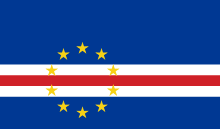Flag of Cape Verde
.svg.png) | |
| Use | National flag and ensign |
|---|---|
| Proportion | 2:3 (de facto) |
| Adopted | 22 September 1992 |
The national flag of Cape Verde was adopted on September 22, 1992, replacing the flag adopted during Cape Verdean independence, fought for with Guinea-Bissau, another former Portuguese colony on mainland West Africa.
Description
The 10 stars on the flag represent the main islands of the nation (a chain of islands off the coast of West Africa). The blue represents the ocean and the sky. The band of white and red represents the road toward the construction of the nation, and the colours stand for peace (white) and effort (red). The yellow colour, circular formation of the stars, and dark blue field show similarity to the flag of Europe with 12 stars instead of 10, originally designed for the Council of Europe, but also used by the European Union. The stripes are in 6:1:1:1:3 ratio, and the circle of stars is centred 3/8 along the fly.
Proportions

The Constitution of the Republic[1] does not specify what the official proportions for the height and the width of the flag are. The dimensions of the parts that make up the flag are given proportionally to the dimensions of the sides, without specifying those dimensions. However, the proportion most widely used is 2:3,[2] which is the same proportion that was used in the flag prior to 1992. Consequently, the proportion of 2:3 is the de facto (but not de jure) proportion.
Colour shades
The Boletim Oficial gives the official shades of the flag's colours (as well as the colours of the Arms of the Republic):[3]
| Color | Pantone | Web colors | RGB | CMYK | HSV |
|---|---|---|---|---|---|
| Blue | 287C | #003893 | 0, 56, 147 | 100%, 89%, 8%, 2% | 218.69°, 100%, 55.47% |
| White | - | #ffffff | 255, 255, 255 | 0%, 0%, 0%, 0% | 0, 0, 100% |
| Red | 186C | #cf2027 | 207, 32, 39 | 12%, 100%, 100%, 3% | 347.31°, 98.49%, 80.31% |
| Yellow | 116C | #f7d116 | 247, 209, 22 | 4%, 15%, 98%, 0% | 47.74°, 100%, 100% |
The Pantone, CMYK and RGB are official as published in the bulletin. The other colour shades (Web and HSV) are interpretations of the Pantone standards.
History
Before independence, Cape Verde did not have an official flag. In the late 1960s, a flag for the Portuguese overseas province of Cape Verde was proposed, consisting of a flag of Portugal defaced with the provincial arms shield in the lower fly. However, this flag was never adopted.
The original national flag of Cape Verde was introduced on independence in 1975, based on that of the Partido Africano para a Independência da Guiné e Cabo Verde (PAIGC), with the common African colours of red, green and yellow. It is identical to the flag of Guinea-Bissau except for the charge in the hoist-side stripe. Their similarity evoked the plans to unite both countries, which, however, were abandoned shortly after independence. Guinea-Bissau gained independence September 10, 1974.
-
.svg.png)
Proposed flag of the province of Cape Verde
-
.svg.png)
Prior national flag of Cape Verde (1975–1992)
References
External links
| ||||||||||||||
| ||||||||||